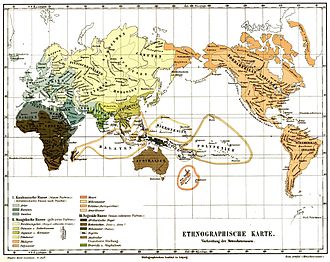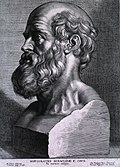Historical race concepts

| Caucasoid: Aryans Semitic Hamitic Negroid: African Negro Khoikhoi Melanesian Negrito Australoid Uncertain: Dravida & Sinhalese | Mongoloid: North Mongol Chinese & Indochinese Korean & Japanese Tibetan & Burmese Malay Polynesian Maori Micronesian Eskimo & Inuit American |
Some scientists sorted human beings into three groups. These groups were called races: The Caucasian race living in Europe, North Africa and West Asia, the Mongoloid race living in East Asia, Australia, and the Americas, and the Negroid race living in Africa south of the Sahara. Other scientists spoke of four or five races.
These ideas were popular from the late 18th century to the middle of the 20th century. These are now called historical definitions of race or historical race concepts. Today, scientists agree that there is only one human race. Modern genetic research has shown that the idea of three (or four, or five) races was wrong.[1][2]: Script error: The function "hyphen2dash" does not exist. 
19th century
Johann Friedrich Blumenbach's classification, first proposed in 1779,[3] was widely used in the 19th century, with many variations.
- Ethiopian/black race.
- Caucasian race/white race
- Mongolian/yellow race
- American/red race
- Malayan/brown race
Middle of the 20th century
The mid-twentieth century racial classification by American anthropologist Carleton S. Coon, also used five races but divided some of them differently:
- Negroid (Black) race
- Australoid (Australian Aborigine and Papuan) race
- Capoid (Bushmen/Hottentots) race
- Mongoloid (Oriental/Amerindian) race
- Caucasoid (White) race
Racism

There was much prejudice based upon this way of thinking and speaking. It argued that in the races that make up the human race, there are deep, biologically determined differences.
Someone who partakes in racism is called racist. These are the attitudes that in turn supported the horrors of African slavery, Apartheid, the Jim Crow laws, Nazism, and other crimes against humanity.
Problems with defining races
As described above, people tried to define "races", but they had many problems. In 1797, Johann Friedrrich Blumenbach wrote in his manual Handbuch der Naturgeschichte that he was unable to differentiate between different kinds of black people, such as Abessynians and Moors.[5] Charles Darwin similarly wrote that he was unable to find significant differences between races.[6] There are also other problems: Scientists say that the concept of a "race" is not useful or necessary for research.[7] They cannot agree on the definition of what a given race is, and they do not even agree on the number of races.
After discussing various criteria used in biology to define subspecies or races, Alan R. Templeton concludes in 2016: "[T]he answer to the question whether races exist in humans is clear and unambiguous: no."[2]
Historical Race Concepts Media
References
- ↑ American Association of Physical Anthropologists (27 March 2019). "AAPA Statement on Race and Racism". American Association of Physical Anthropologists. Archived from the original on 25 January 2022. Retrieved 19 June 2020.
- ↑ 2.0 2.1 Templeton A. 2016. Evolution and notions of human race. In Losos J. & Lenski R. (eds) How evolution shapes our lives: essays on biology and society (pp. 346-361). Princeton; Oxford: Princeton University Press. . That this view reflects the consensus among American anthropologists is stated in: Wagner, Jennifer K.; Yu, Joon-Ho; Ifekwunigwe, Jayne O.; Harrell, Tanya M.; Bamshad, Michael J.; Royal, Charmaine D. (February 2017). "Anthropologists' views on race, ancestry, and genetics". American Journal of Physical Anthropology. 162 (2): 318–327. doi:10.1002/ajpa.23120. PMC 5299519. PMID 27874171.
- ↑ The anthropological treatises of Johann Friedrich Blumenbach. Google Books The anthropological treatises of Johann Friedrich Blumenbach
- ↑ American Association of Physical Anthropologists (27 March 2019). "AAPA Statement on Race and Racism". American Association of Physical Anthropologists. Retrieved 16 July 2020.
Instead, the Western concept of race must be understood as a classification system that emerged from, and in support of, European colonialism, oppression, and discrimination.
- ↑ Johann Friedrich Blumenbach (1797). Handbuch der Naturgeschichte. p. 62. Retrieved 2020-06-06.
die Neger, die sich dann in die Habessinier, Mauren ꝛc. verlieren, so wie jede andre Menschen-Varietät mit ihren benachbarten Völkerschaften gleichsam zusammen fließt.
[the negroes, who then lose their characteristics into the Abyssinians, the Moors etc., the same way in which every other variety of man flows together with the neighbouring ethnic groups, so to speak] - ↑ "It may be doubted whether any character can be named which is distinctive of a race and is constant... they graduate into each other, and.. it is hardly possible to discover clear distinctive characters between them... As it is improbable that the numerous and unimportant points of resemblance between the several races of man in bodily structure and mental faculties (I do not here refer to similar customs) should all have been independently acquired, they must have been inherited from progenitors who had these same characters.", Charles Darwin, The Descent of Man p. 225 onwards
- ↑ Lieberman, L. (1997). ""Race" 1997 and 2001: A Race Odyssey" (PDF). American Anthropological Association. p. 2. Archived from the original (PDF) on 2021-01-10. Retrieved 2021-04-18.




